- New Sailboats
- Sailboats 21-30ft
- Sailboats 31-35ft
- Sailboats 36-40ft
- Sailboats Over 40ft
- Sailboats Under 21feet
- used_sailboats
- Apps and Computer Programs
- Communications
- Fishfinders
- Handheld Electronics
- Plotters MFDS Rradar
- Wind, Speed & Depth Instruments
- Anchoring Mooring
- Running Rigging
- Sails Canvas
- Standing Rigging
- Diesel Engines
- Off Grid Energy
- Cleaning Waxing
- DIY Projects
- Repair, Tools & Materials
- Spare Parts
- Tools & Gadgets
- Cabin Comfort
- Ventilation
- Footwear Apparel
- Foul Weather Gear
- Mailport & PS Advisor
- Inside Practical Sailor Blog
- Activate My Web Access
- Reset Password
- Customer Service

- Free Newsletter


Tartan 30: An Affordable Classic

Ericson 34-2 Finds Sweet Spot

How to Sell Your Boat

Cal 2-46: A Venerable Lapworth Design Brought Up to Date

Solar Panels: Go Rigid If You have the Space…

Leaping Into Lithium

The Importance of Sea State in Weather Planning

Do-it-yourself Electrical System Survey and Inspection

When Should We Retire Dyneema Stays and Running Rigging?

Rethinking MOB Prevention

Top-notch Wind Indicators

The Everlasting Multihull Trampoline

What Your Boat and the Baltimore Super Container Ship May Have…

Check Your Shorepower System for Hidden Dangers

DIY survey of boat solar and wind turbine systems

What’s Involved in Setting Up a Lithium Battery System?

Waste Not is the Rule. But How Do We Get There?

The Scraper-only Approach to Bottom Paint Removal

How to Handle the Head

The Day Sailor’s First-Aid Kit

Choosing and Securing Seat Cushions

Cockpit Drains on Race Boats

Re-sealing the Seams on Waterproof Fabrics

Safer Sailing: Add Leg Loops to Your Harness

Waxing and Polishing Your Boat

Reducing Engine Room Noise

Tricks and Tips to Forming Do-it-yourself Rigging Terminals

Marine Toilet Maintenance Tips

Learning to Live with Plastic Boat Bits
- Sailboat Reviews
Tartan 33: Scheel Keel Pioneer
The tartan 33’s offshore ambitions are evident in cynosure, owned by practical sailor contributor bill herrmann..
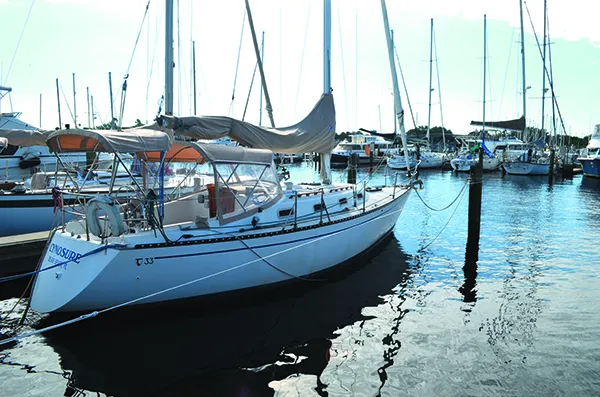
By the late 1970s, the old Tartan 34 had become very dated. The boat had been in production for a decade, and hundreds of families had cut their racing and cruising teeth on the S&S keel/centerboarder. But the market was changing. Boats were faster and lighter, keels and rigs more efficient, interiors roomier and more functional.
Tartan 33 Specs
In 1978, Tartan brought out the Tartan Ten, a 33-foot, fairly light, fractionally-rigged “offshore one design.” The boat was a huge success: fast, easy to sail, and unencumbered by the design limitations of a rating rule.
But the Tartan Ten had one big problem: limited accommodations with stooping headroom, an interior most kindly described as spartan. A hardy crew could take the Tartan Ten on a multi-day race such as the Mackinac, and you might even coax your family aboard for a weekend of camping out. But cruising or extended racing in comfort? Forget it!
If, however, you could combine the size and performance of the Tartan Ten with a boat having decent accommodations, you had a good shot at a winning combination, particularly in a time when interest in sailing was growing at an astounding rate. As a bonus, the venerable Tartan 34 could be retired with the dignity she deserved.
The answer to all these prayers was the Tartan 33. Introduced as a 1979 model, the Tartan 33 bore a strong resemblance to the Tartan Ten, with a big fractional rig, flattish sheer, and wide stern. But unlike the Tartan Ten, the new 33 had good accommodations.
The Tartan 33 was a moderate success, with about 220 boats built over a five-year period. The fractional rig, touted as being easier to handle due to smaller headsails, may have turned off some customers who associated that type of rig with high performance boats such as J/24s and 12 meters. The slotted aluminum toe-rail of the 33 was more reminiscent of Tartan’s racing boats, such as the 41 and the Ten, than it was of a high-quality cruiser/racer.
In 1984, the Tartan 33 went out of production. In its place came the “new” Tartan 34, a boat that could directly cash in on the reputation of the famous old Tartan 34. Interestingly, the new Tartan 34 is the Tartan 33, with the stern drawn out 9 inches to a more pleasing termination, the interior redesigned to meet market demands, and the 33’s fractional rig replaced by the masthead rig of the Tartan 33R.
Compared to the Tartan 33, the new 34 is more finely finished, with teak toerails and nicer interior detailing.
When first introduced, the Tartan 33 had a base price of just over $46,000. By the time production ceased, the base price had increased to $66,000. Remember, those were the years of double-digit inflation.
Sailing Performance
As originally configured—Scheel keel and fractional rig—performance of the Tartan 33 might be a little disappointing for someone coming from a Tartan Ten, but is certainly on a par with most other boats of the same size, type, and vintage. In absolute terms the Tartan 33 is spritely, but not stunning, with a PHRF rating of about 160. By comparison, the old C&C 34—a good all-around cruiser/racer from the same period—rates 144, 16 seconds per mile faster. The C&C 34 and Tartan 33 are almost identical in length, sail area, and displacement.
In lighter winds, the fractionally-rigged Tartan 33 is at its biggest disadvantage, particularly off the wind. The big mainsail allows you to sail fairly low, but you go pretty slow. By comparison, a boat with a big masthead spinnaker will be sailing a little higher and quite a bit faster for optimum off-wind VMG in the same conditions.
The Tartan 33’s interior departs from the norms for cruising boats in this area. Most owners who have lived with the interior for some time find it quite workable, but the boat’s successor, the T-34, better addresses the cruising sailor’s accommodation needs.
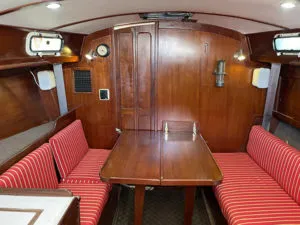
- Bifold doors separate main cabin from the head, which extends across the width of the boat, just aft of the v-berth. The drop-down table dines four comfortably. A short settee—less than 5-feet long—with the icebox occupying a high counter at what would normally be the head of the berth.
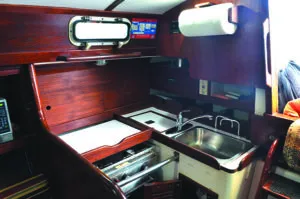
- The L-shaped galley is serviceable but counter space is at a premium.
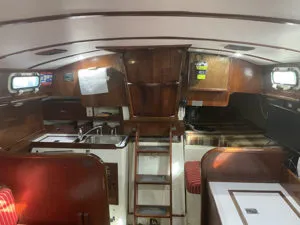
- A quarterberth offers snug cubby for guests, but its usual function is a mini-garage.
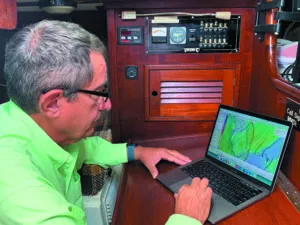
- The navigator sits in a snug cutout, so it’s a bit of a stretch to reach the electrical panel outboard. Laptop navigation is unimpeded.
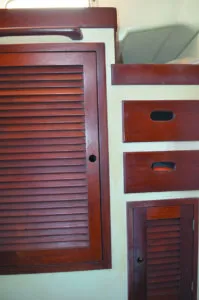
- Owners praise the joinery on the Tartan. There are no veneer laminates, only finely joined solid wood. There is more storage than one would expect in a boat of this size.
IMS (International Measurement System) velocity predictions show that the Scheel keel Tartan 33 must in general be sailed a little lower and flatter than a comparable fin keel boat, although the 33’s righting moment is very similar to that of a fin keel boat of the same size and type, as is her range of positive stability.
The Tartan 33 was not designed to any rating rule, but a number have been rated under the IMS. In some areas, there are enough of the boats to allow them to sail together as a one-design class, but the boat is not fast enough in absolute terms to stir the blood of most sailors interested in one-design racing. In addition, Tartan 33 sailors disagree on the proper amount of headsail overlap for the boat, making level racing more difficult.
To offset the rather average performance of the Tartan 33, the 33R was introduced in 1982. The 33—“R” for “Racing”—has a deep fin keel and a double-spreader masthead rig. The difference in performance between the 33 and the 33R is pretty amazing: the 33R is almost 30 seconds per mile faster than the stock 33, even though the sail area is almost identical.
Righting moment of the fin keel and Scheel keel boats is virtually the same, so the extra performance isn’t the result of increased stability. The combination of the fin keel and the masthead rig is simply faster in most conditions.
It’s interesting to compare the performance with the new 34, which combines the Scheel keel of the 33 with the masthead rig of the 33R. Although the specifications for the 33 say the boat is a thousand pounds lighter than the 34, the 33 was never as light as that. The typical 33, in IMS measurement trim, weighs pretty much the same as the new 34—11,000 pounds.
Typically, the 34 has a PHRF rating of about 141 with the optional deep keel, 147 with the standard Scheel keel. This places the 34 pretty squarely between the 33 and the 33R in the performance spectrum, suggesting that the masthead rig accounts for about half the performance difference between the 33 and the 33R.
In order to keep the rig simple, the 33 was designed without running backstays. Instead, forestay tension is maintained by carrying a lot of load on the swept-back upper shrouds. Some 33s that have been actively raced have added running backstays, but they are not necessary if the boat is used strictly for cruising. Our experience with fractional rigs of larger boats is that it is very difficult to maintain adequate headstay tension without runners or jumpers, even though runners are a pain for shorthanded sailing.
If you want the best performance in a Tartan 33, there’s no question that you should look for a 33R. It may be a long look, as relatively few of the higher-performance boats were built. The 33R’s draft of over 6’ 3” could be a disadvantage in areas of shoal water.
The Tartan 33’s deck features are consistent with the boat’s aims to be a multipurpose boat that will appeal to Wednesday night racers and family cruisers alike—and, with some upgrades, be capable of serious offshore adventures.
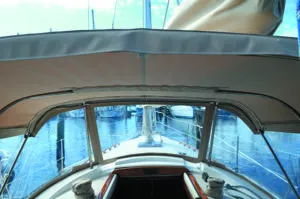
- Visibility from the helm is excellent and cut outs in the dodger breakwater offer a convenient slot for halyards and reefing lines to be led aft, making it easier to change the sail plan without going forward.
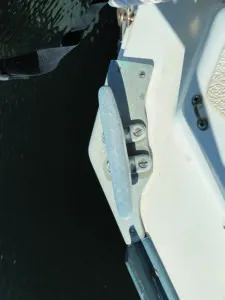
- Cast bronze corner protectors and a rugged 10-inch stern cleat are typical of the hardware throughout.
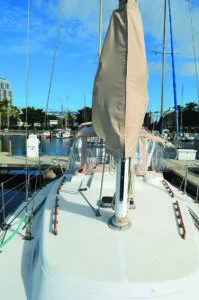
- Handholds extend forward of the mast. The non-skid is surprisingly grippy even on older boats.
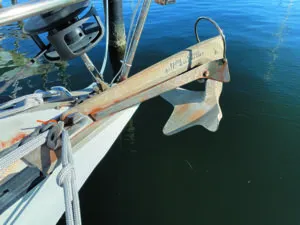
- Anchor rollers and windlasses were not standard, but many owners have added them. The condition of the deck surrounding any aftermarket additions should be closely inspected.
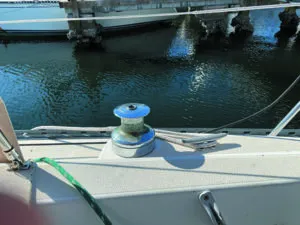
- The Lewmar 40 winches were standard. Many owners have upgraded to self-tailing winches.
One advantage of the fractionally-rigged boat’s large mainsail—it’s just over 300 square feet, about what you’d find on most masthead-rigged 37-footers—is that the boat balances and sails reasonably well under mainsail alone. This is a useful feature for shorthanded cruising, when you may find yourself circling a harbor under sail looking for a place to anchor. With the Tartan 33, you can drop the jib and clear the foredeck for anchoring while still maintaining good sailing ability under mainsail.
Shrouds are set well inboard, and you’ll almost always find inboard genoa tracks just outboard of the cabin trunk, even though it was an option.
Wheel steering was standard on the boat, and the 32-inch wheel provides plenty of power as well as good feedback. The rudder is partially protected by a vestigial skeg, and is a deep, high-aspect-ratio appendage— practically parallel-sided in profile— rather than the more efficient elliptical shape seen in more modern racing boats and performance cruisers.
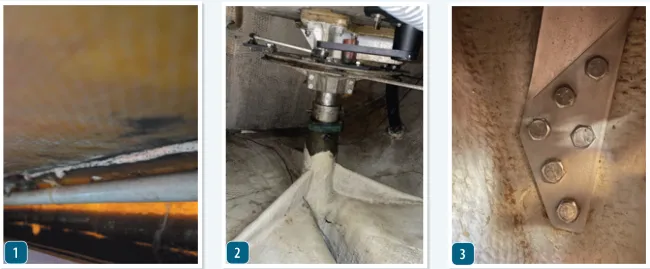
Most of the new boat owners who completed our first survey praised the Tartan 33 for its practical features.
A Lively Ride
The boat is tender, lively, solid, and fun to sail. We got oversize self-tailing winches, and the longer we own the boat, the more convinced we are of this choice. The fractional rig and good cockpit layout allow my wife and me to handle the boat in safety and comfort in high winds and heavy seas. The Scheel keel offers shallow draft with good stability, but performance is a little poor close hauled in slop and light air.
J.D. Cowan Columbus, OH 1980 model
Downwind scooter
With a fractional rig and Scheel keel, she cannot point as well as comparable masthead boats, but the large main gives an off-wind advantage. Since Tartan came out with the 33R with masthead rig and fin keel, I assume that the upwind performance of my boat did not appeal to some racers.
The lower lifelines interfered with the winch handles on the original Lewmar 40s. I eventually put on Lewmar 44 self-tailers, which are taller and allow the handles to swing between the lifelines.
Construction is excellent for a production boat The interior is not as plush as some cruising boats, but it is very utilitarian. For a cruising boat with good racing potential, my boat is fine. It’s my aim to make the boat I have more competitive, not to look for greener pastures with another boat.
D.N. Pevos W. Bloomfield, MI 1980 model
Key Additions
I added a propane stove, larger winches, electric refrigeration, an electric anchor windlass, and larger batteries. I also led the halyards back to the cockpit. I bought the boat for ease of singlehanding (I’m a 5’ tall, lightweight female). I live aboard for much of the summer. The interior is a palace for one, fine for two, a bit tight for three, but in a pinch, okay for four.
R.E. Cathou Lexington, MA 1980 model
The boat is strong and extremely seaworthy. Poor upwind performance is my greatest frustration. The huge main means that I must reef early. The boat is perfectly balanced with a working jib and a full main, but this isn’t exactly optimum for racing. Warranty claims included minor flaws in the gelcoat, which Tartan repaired shortly after delivery. A great designer (S&S) and a good builder equal strength and quality.
B. Weiss Stamford, CT 1981 model
Cockpit layout is efficient for sailing, but is somewhat better for cruising than for racing. A mainsheet traveler spans the cockpit well, just forward of the wheel, and genoa sheet winches are outboard of the main coamings, just forward of the traveler. For racing, it would be better to have the genoa winches further forward, so that trimmers would be well clear of the helmsman, and their weight would be further forward. For single-handed or shorthanded cruising, however, the location is almost ideal.
Unfortunately, self-tailing winches were not standard equipment. The stock Lewmar 40s are about the right size for the fractional foretriangle, but would be a little small on a masthead rig with a 150% genoa. Sparkman & Stephens is one firm that can always be counted on to design in a molded dodger breakwater, and Tartan has faithfully put them on their cruiser/racers over the years. Other builders should take note of the simple, functional breakwater on the Tartan 33, which has openings molded in to allow halyards to be led aft if you want to set the boat up for singlehanding.
Construction
Tartan has always had the reputation of being one of the country’s higher-quality production builders, and they deserve it. In general, owners report very few construction shortcomings, and very few warranty claims.
Four owners in our survey had gelcoat blistering problems. That does not constitute an unusually large percentage, but interestingly, the boats reported as having blisters were two pairs that were sequential in the production series. That may be a coincidence, but it’s an unusual one.
Balsa coring is used in both the hull and deck of the Tartan 33. If you replace or move any deck or hull fittings, be sure to seal any exposed balsa with epoxy resin before installing new hardware.
The hull-to-deck joint is made with a standard inward-turning hull flange, overlapped by the deck molding, which is bolted to the hull through an anodized aluminum toerail. The joint is bedded with both butyl and polysulfide. Builders like to use butyl as a bedding compound, since it’s cleaner to use than most gunned compounds such as polysulfide or polyurethane. Butyl has no adhesive properties, however, and in our experience it can be squeezed out of a joint over time if you continue to tighten down bolts to cure a leak. Since only one owner in our survey reported any deck leaks, Tartan’s combination seems to work well.
Several owners complain about the lack of a top-loading anchor well. Wells can be a nuisance when racing, since they frequently hold a fair amount of water. For coast-hopping, however, an top-loading well in the lets you easily clear the foredeck of gear.
There is an absolute minimum of exterior wood on the Tartan 33: handrails atop the cabin, trim around the companionway. The boat is much more austere than you think of when Tartan comes to mind, but the racing Tartans have always been pretty basic.
Two-tone decks were an option, although the standard monotone deck was available either in white or a light buff. With the two-tone deck package, non-skid areas on the deck, coaming tops, cockpit seats and deckhouse were a nice buff color, contrasting with the stark white of the rest of the deck molding. If you buy a monotone boat, the areas could be painted a contrasting color. A white Tartan 33 with white monotone decks is a plain vanilla boat, indeed.
You’ll find a three-cylinder, 24-hp Universal diesel in every Tartan 33. Owners report that the engine has been smooth-running and reliable, and that it’s adequate power for the boat. An aluminum fuel tank holds 26 gallons, giving a range of about 200 miles under power.
All in all, there’s little to quibble with in the design and construction of the Tartan 33: it’s simple, straightforward, and well executed.
The interior layout of the Tartan 33 has both fans and detractors. The head configuration, for example, is something you either love or hate. To give more room, particularly for showering, the head compartment runs the full width of the boat. A bi-fold door shuts off the head from the forward cabin, and another bi-fold door closes the head to the main cabin. Two opening ports provide ventilation in fair weather.
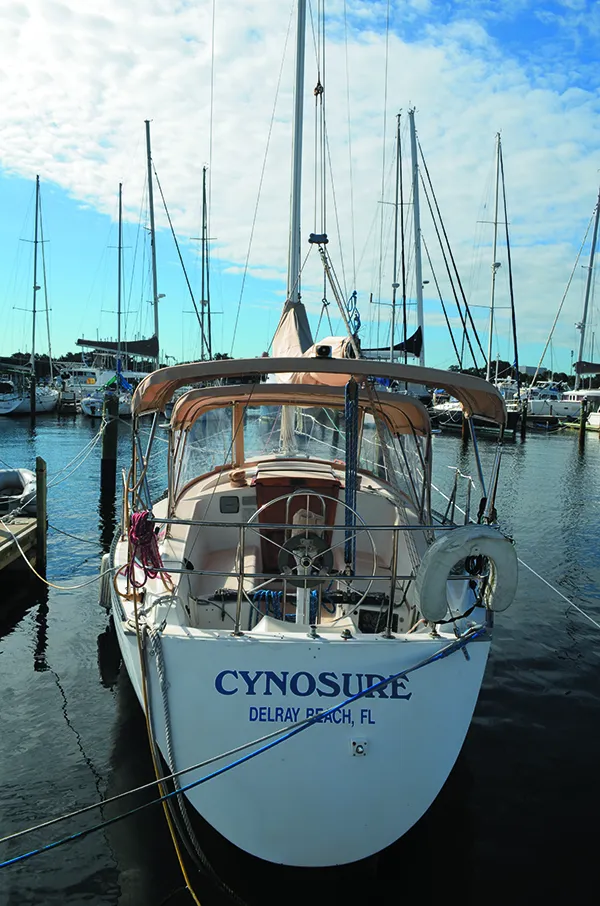
The difficulty with this arrangement is that you cannot get either into or out of the forward cabin if someone is using the head. This wouldn’t be a problem for cruising with a couple, but it could be a nuisance with a lot of people aboard. Closing the door to the forward cabin also cuts off ventilation forward, unless the weather is good enough to have the foredeck hatch open.
The problem is made even worse when the insert is used in the V-berth to form a double. This completely eliminates any standing room in the cabin, so that you climb into the berth directly from the head compartment.
It works, but there’s a fair amount of psychological resistance to the arrangement, since it is one usually seen on smaller boats.
Ironically, the full-width head is a really good one, with plenty of elbow room for showering and dressing. Even without the berth insert in place, standing room in the forward cabin is marginal, and headroom is very limited.
While the forward berths are quite long, they are extremely narrow at the foot, so that two tall people will be tangling feet if they use the berths as two singles. As a double, sleeping parallel to the centerline, this is less of a problem.
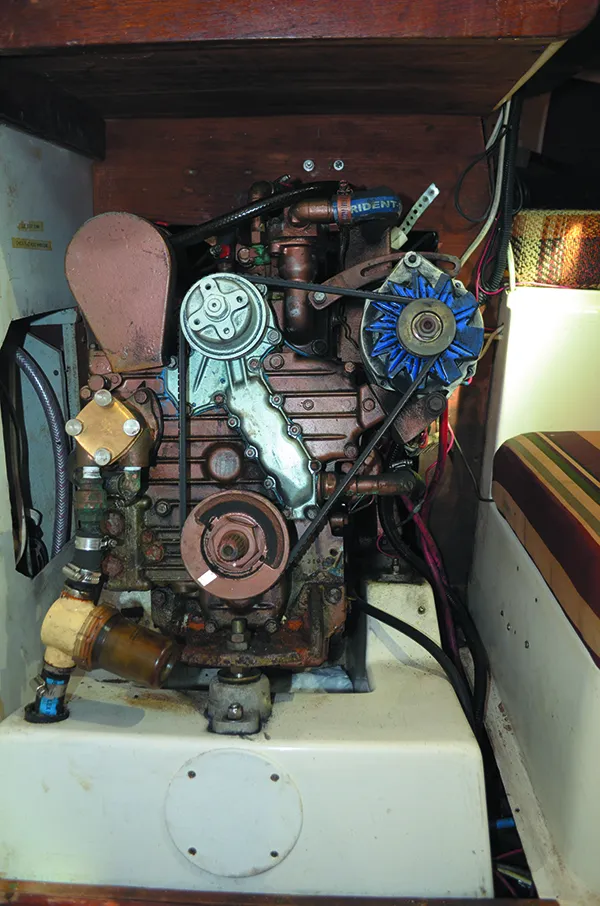
My 1980 Tartan 33 Cynosure still turns heads. But like any piece of machinery, the Tartan 33 needs to be maintained. For someone looking at a used Tartan 33, or other Tartan from that era, here are some areas of concern.
- Chain plate area – Tartan chain plates are a flat slab of stainless steel that passes through the deck and mounts to the mid-ship bulkhead. The through-deck area includes an escutcheon plate. Part of normal maintenance is renewing the chalking/waterproofing in this area. Throughdeck leaks usually first show as discoloration on the chain plate. Leaks can lead to bulkhead damages as well.
- Genoa tracks – As these boats age, the waterproofing on the Genoa tracks needs renewing. The good news is that the port side is super easy. Remove a piece of molding over the pilot berth, and with some help from someone topside you can loosen the fasteners. The starboard side is not so easy. To access the nuts under the Genoa track requires removing the top of the cabinets and one of the partitions.
- Portlights – At this point in their life cycle the Beckson ports are likely to leak, which stains or harms the interior teak. It is possible to replace the lenses and renew (clean) the rubber gaskets, but purchasing new Beckson ports is often the best option.
- Engine – The Universal 5424 /Kubota engine is a classic old-school diesel. Be sure to show the engine you care- change the oil, give her clean fuel and keep her cool, and she will run fine. At this point in the engine’s life consider replacing the glow plugs and replacing or rebuilding the injectors.
- Starboard drinking water tank- These tanks are famous for leaking. I finally decided to place a collapsible tank inside my existing tank.
Room for improvement
- Sails – The best way to both enhance your ride and be the envy of sailors with newer production boats is to put a good set of sails on her.
- Jib shaping – the T-33 is a roller furling fractional rig with the ability to point fairly well. The compromise to this design is that keeping the correct jib sheet angle (vertical and inboard/outboard) is a challenge. The reward for good sail quality and good sheet angle is a peppy old boat (think 60% TWS). So how do you get your jib angle right?
1) Purchase Garhauer adjustable cars. This relatively inexpensive upgrade allows you to easily open and close the leech regardless of reef.
2) Purchase 2-3 snatch blocks. When the AWA is 80 degrees or higher, the jib develops a hook. This is where the slotted toe rail comes in handy (aside from not needing varnish). Take the jib sheet through a snatch block mounted at the boarding gate and then through the genoa car (pulled fully aft), which creates an effective jib shape.
- Jib size – When I purchased my boat she had a 135 and a 150 that was a thin light-air sail. I found the 150 to be simply too much sail in winds above 10 knots. When it came time to replace my jib, I purchased a 135%, 8.1-oz., tri-radial jib. Soon after, she had a matching 8.1-oz. tri-radial main (see cover photo).
- Main sail trim – The relatively large main sail requires attention. The T-33 likes to sail more upright so be ready to ease the main (under-trim) in the gusts.
- Ice box – Most of these boats have been retrofitted with refrigeration. Consider adding 1” of pink foam to make the ice box more efficient.
- Cabin overhead – when replacing the wood and fabric in my overhead I placed ½-inch insulation and added recessed lighting. Replacing the wood and fabric eliminated the old-boat-smell. Adding recessed lighting with switches by the companionway made the cabin much brighter.
- Countertops – The paucity of veneer, means dings to the wood can be oiled to darken, which then become part of the boat’s patina. The exception is its Formica countertops, which will yellow with age. With some basic wood working skills, the Formica can be easily replaced.
Practical Sailor boat reviewer and products and electronics tester Capt. William Herrmann is a delivery skipper based in St. Petersburg, Florida. His website is www.uscgcaptain.com .
The main cabin layout is also unusual. To starboard, there is a fairly standard settee that extends to form a reasonably-sized double, with a shelf outboard. A dining table folds up against the starboard forward bulkhead.
On the port side, the arrangement is less standard. Instead of a normal settee berth, there is a short settee—less than 5-feet long—with the icebox occupying a high counter at what would normally be the head of the berth. This short settee could function as a berth for a child, but obviously not for an adult. Outboard of the settee, there is a narrow pilot berth, which is comfortable and secure, and fortunately isn’t jammed as high under the side decks as they frequently are.
Main cabin ventilation is provided by six opening ports, two cowl vents in dorade boxes, and an aluminum-framed centerline hatch, which was an option, but a common one.
The galley—aft on the starboard side—is not the most efficient in the world, since you have to turn around and step across the main cabin to reach the icebox. In addition, the icebox top is the only usable food preparation counter space, which puts the cook in the middle of the main cabin traffic flow.
A two-burner alcohol stove was standard equipment, but a large percentage of boats have the optional three-burner gimbaled alcohol stove with oven. A deep single sink is just aft of the stove, but it’s a bit of a reach to use, since the flat of the cabin sole doesn’t extend very far outboard in this part of the hull.
Aft of the icebox is a sit-down chart table. The working surface is a reasonable size, and the outboard locker could be sacrificed for the installation of electronics.
While there is a contoured, upholstered seat for the nav station, it does not exactly face the chart table, and it is offset from the center of the table. The navigator has to make a bit of a stretch to reach the outboard part of the table, or to use any electronics that might be mounted outboard.
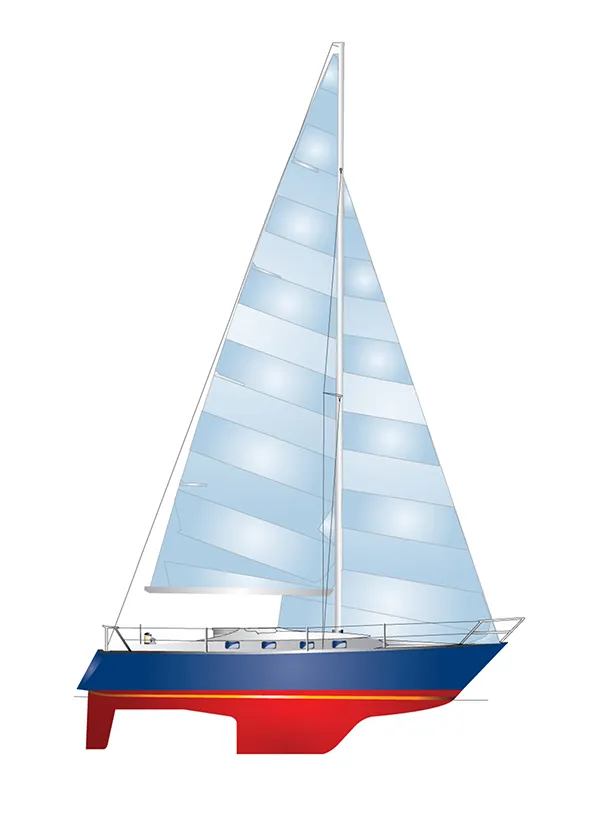
Tartan 33 in Context
Aft of the nav station is a big double quarterberth. A drop-in insert which covers the nav station seat forms the head of the inboard portion of the quarterberth, although the berth can be used as a single without disturbing the navigator. This is basically the same quarterberth layout used in the Tartan 37. Awkward on the 37, it’s a bit more acceptable on a smaller boat where space is at even more of a premium.
Most owners who have lived with the interior for some time find it quite workable. A top Tartan dealer told us, however, that he has definitely seen buyer resistance to it. Certainly the redesigned interior of the Tartan 34 is substantially better.
Conclusions
If you’re looking for a fairly fast, high-quality, late model cruiser/racer, with a great owner support group, the Tartan 33 is a good choice. In general, prices will be very comparable to those of other quality boats of the same size and vintage, such as the C&C 34 and Sabre 34. Performance of these three boats is also similar.
TARTAN, www.tartanyachts.com TARTAN OWNERS NORTHEAST, https://tone.clubexpress.com/
RELATED ARTICLES MORE FROM AUTHOR
Thank you for the well researched and informative review with comparisons for Tartan 33. Especially good consideration of sails and adjustments.
LEAVE A REPLY Cancel reply
Log in to leave a comment
Latest Videos
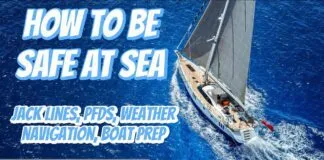
Safety At Sea For You & Your Family – The Joe...

What’s The Best Vinyl Window Cleaner for Your Boat?

40-Footer Boat Tours – With Some Big Surprises! | Boat Tour

Electrical Do’s and Don’ts
- Privacy Policy
- Do Not Sell My Personal Information
- Online Account Activation
- Privacy Manager
Tartan 33 hull 1 20
The tartan 33 hull 1 20 is a 33.67ft fractional sloop designed by sparkman & stephens and built in fiberglass since 1979..
The Tartan 33 hull 1 20 is a light sailboat which is a reasonably good performer. It is very stable / stiff and has a low righting capability if capsized. It is best suited as a coastal cruiser.
Tartan 33 hull 1 20 for sale elsewhere on the web:

Main features
Login or register to personnalize this screen.
You will be able to pin external links of your choice.

See how Sailboatlab works in video

We help you build your own hydraulic steering system - Lecomble & Schmitt
Accommodations
Builder data, modal title.
The content of your modal.
Personalize your sailboat data sheet

- Forum Listing
- Marketplace
- Advanced Search
- About The Boat
- Boat Builders Row
- SailNet is a forum community dedicated to Sailing enthusiasts. Come join the discussion about sailing, modifications, classifieds, troubleshooting, repairs, reviews, maintenance, and more!
- Add to quote
Hello, Regarding the Tartan 33 (1979-1984), I'm considering this boat for purchase and would be interested in hearing opinions and impressions from current and/or past owners. In particular, sailing characteristics at different points of sail, potential speed, and problems to be aware of in a 30 year old boat in addition to the normal balsa core issues. Thanks in advance for any response.
No first hand exp. w/Tartan 33. I am familiar with the T27 & T30 which were from that era and I can say that they were well made boats. I do note that there seem to be 3 "flavors" of the T33 listed here: TARTAN 33 sailboat specifications and details on sailboatdata.com Std. fractional rig, Masthead rig & small masted rig. Masthead rig = more sail area. Also of note is that this is a "sheel" keel boat. The sheel keel was S&S's idea for a shoal draft boat. Shoal draft boats tend to not point as high upwind as a standard fin keel design.
I have been interested in T33 as well. Is the sheel keel encapsulated, or bolted on?
I bought one back in April. The keel is bolted on.
Thanks, Ajax. How do you like that boat? You think it can cross Atlantic when properly outfitted?
I know that some of these boats have made the trip to Bermuda. Properly outfitted and sailed with prudence, I guess I can't see why it couldn't go all the way. How do I like it? I absolutely love it. I thought the Pearson 30 was a decently built boat and this is an order of magnitude better. They come with 60-ish gallons of fresh water tankage, which by today's standards is a bit light for blue water sailing. You could install a composting head and replace the holding tank with another 19 gallons of fresh water if you were so inclined. I was concerned about windward performance with the Scheel keel but I find that it's no worse than the Pearson was. It gets close enough to the wind. They are reaching machines. I've had mine up to 10 kts a couple of times now. I find the boat to be plenty spacious for my needs, with plentiful, well thought out stowage compartments. These are fractionally rigged boats (in case you didn't know). The mast is quite tall and the boat carries a lot of cloth with a full main and 140% genoa. All the other T-33 owners I've talked to, state that 135-140% is plenty, even for light air venues. Don't bother with the traditional 155% or bigger genoa. This also means that if you're sailing across the pond, I would ensure that your main has at least two deep reef points, carry a trysail and a storm jib and a working jib. Being over canvassed in this boat is not fun, wise, or good for the boat. The deck hardware is all good quality and adequately sized. The primaries are Lewmar 2-speed 42's. Edson wheel steering with emergency tiller. My boat still has the original Universal M-30 (5424) diesel which apparently is a Kubota tractor engine. These are good, reliable engines but they are getting long in the tooth and some of the marine parts are getting difficult to find, especially the exhaust manifold/riser. Otherwise, you can still buy most parts from marine sources and tractor engine sources if you refer to the engine block by the part number stamped on the oil dipstick. If you tell a Kubota dealer than you have a Universal, they won't know what you're talking about. Engine access overall, is excellent. The lazarette is huge and access to the stuffing box, steering gear, diesel exhaust and various overboard discharges is excellent. The boats came with Hurth transmissions which have kind of a mediocre reputation for reliability. The best advice I can give you, is change the fluid annually with good quality, Dexron/Mercon II or III fluid. Do NOT use Dexron VI fluid. You can use Type "F" fluid if you can find it, but the transmission engagement will be a bit harsh. There is no filter in the transmission. The cabin sole is susceptible to water damage from repeated overfilling of the stbd water tank. According to Tartan (and my experiences), the boat (due to the Scheel keel) prefers to be sailed flat. If you insist on pinching to windward, the keel will stall. Foot off a bit and drive a little extra distance much faster and your VMG will be just as good or better. There is an "R" variant that is a masthead rig with a deep, standard keel that was made in limited numbers. The 34-2 is merely a 33R that has been stretched 6 inches so maybe you can find one of them. I've only owned the boat since April, so that's all I know right now.
Thanks for this very good write-up, Ajax. Tartan builds quality boats and even when 30+ years old they seem to hold up nicely. I have about a year to pull a trigger on a boat that I plan to retire on and take it to the Caribbean and Med. I budgeted about 40K for the boat and basic improvements to it. Looking at boats in the 30-35' range, like T33, T34 (1 and 2). I'm not a big fan of bolt on keels but some builders do a better job than others when it comes to such keels.
The Pearson 30 had an encapsulated keel so I can appreciate what you're saying. I was kind of miffed at giving up my encapsulated ballast, but Tartan does it right and I trust the bolts and keel stub. You can trust this boat.
When I was shopping for a boat in this size range 6 years ago, the Tartan 34-2 was on my short list. I liked that it had the masthead rig of the 33R (and thus was faster than the T33) and the bit of extra length allowed a revision to the interior layout which I thought was an improvement. Do a comparison if you are serious about these boats.
The boat I like the most in that group is the older T34 with an inner stay sail rig and a tiller. Shallow draft is a big plus in places where I intend to do most sailing. That is why I'm interested in the sheel keel Tartans as well.
krisscross said: Shallow draft is a big plus in places where I intend to do most sailing. That is why I'm interested in the sheel keel Tartans as well. Click to expand...
- ?
- 174K members
Top Contributors this Month

Comfortable daysailing and coastal cruising can be found on this classic S&S design
There is a nice, clean Tartan 33 sitting on the hard at Spring Cove Marina in Solomons, Maryland. Although I have never sailed it, I have come to know the boat quite well. I have crawled through, around and over it during a couple of the boat-buying workshops I run. I've examined the bilge pump hoses, the rudder bearings, the standing rigging and chainplates. In the process I have come to appreciate the quality of its design and construction. And when I finally sailed a sistership a few months ago on Biscayne Bay, I was impressed with its overall performance. It sailed like a Tartan and that's a compliment. Although it's one of the last Tartans designed by Sparkman & Stephens, the 33 is not as well known or as highly regarded as other models like the 30, 34, 37, Tartan Ten and 41. And that actually works to the advantage of the used boat buyer. The 33 was in some ways a response to both the success and limitations of the flush-deck, one-design Tartan 10. While the T-10's popularity clearly demonstrated that there was a market for a 30-foot Tartan, its one-dimensional design turned off less competitive sailors who also wanted to cruise. The 33, with its comfortable accommodations and easy to handle fractional rig, was the logical solution. Logical or not, the 33 struggled to carve a niche in the tight sailboat market of the early 1980s. Launched in 1979, just over 200 hulls were built before the boat was replaced with the Tartan 34-2 in 1984. While those numbers would make a builder envious today, back in the glory years of production sailboats they were mediocre.
First impressions The 33 has the classic Tartan-S&S profile. A rakish entry trails into a subtle sheer and reverse transom. The overhang ratio is just 14%, but it looks like more. The low-profile cabinhouse blends into a beefy dodger breakwater, which is a Tartan trademark. The cockpit coaming gently continues the linear flow aft. One of the design parameters of the 33 was to reduce brightwork, and most boats feature an aluminum toerail. Shoal draft was also an important feature, and the standard Scheel keel produced a draft of just 4 feet, 5 inches. The fractional rig had mixed results with the sailing public. Some liked the idea of a big main and small headsail, recognizing that the ease of not dealing with big headsails was a plus. Still, this was the age of the genoa, and something about a fractional rig on a 33-footer suggested weird new-age thinking. A later version of the 33, the 33R, for racing, had a masthead rig and deep-draft fin keel. It was, by most accounts, a much faster boat.
Construction The Tartan 33 hull and deck are balsa cored. The forward section of the hull is solid fiberglass below the waterline. The hull and deck are joined on an inward facing flange and the through-bolts anchor the aluminum toerail, making it a structural component of the hull. The bulkheads are well tabbed to the hull. Molded liners are used in the forward and aft sections, as well as in the galley and head. Liners clean up the construction process, however the secondary bondings have to be done right. Both keels, the Scheel and the 6-foot, 3-inch deep fin on the 33R model, are externally bolted to a keel stub. In fact, the same stub is used for both models and results in a void along the stub in the deep keel models. It is not structural. The keel bolts are easily accessed for inspection in the bilge. What to look for Don't confuse the T-10 and 33R with the 33. I was telling a friend about how the 33 was a good value and he was excited because he'd seen one for less than $10,000. It was an old, beat-up T-10. Like all boats, there are some common problems to look for in the 33. Check the mast step, specifically the bridge and the base of the mast, for signs of corrosion. Mast wiring issues have also been reported as a result. Also, the starboard water tank apparently leaks occasionally and delaminates the sole. A survey will reveal the extent of hull blistering, and the 33 was not immune to this malady. All age-related items should be checked, including the standing and running rigging, the chainplates and the steering cables. The cored decks should be sounded for signs of delamination and the surveyor will put a meter on the hull to check moisture content.
On deck The cockpit is workable, and after you sail the boat, you will come to appreciate it. The traveler spans the cockpit just forward of the wheel, and it's well positioned for efficient sheeting. Wheel steering was standard and the helmsman is a bit removed from the sheet winches. Most 33s were built before self-tailing winches were standard, so if the previous owner has updated the winches that's a plus. The 33 was originally set up with the halyards at the mast. However, the dodger breakwater was equipped with fairleads for routing them aft and many owners have made this change. There is a large lazarette to starboard but otherwise no additional storage in the cockpit. A few sheet bags would be a nice touch. There is a narrow bridgedeck. The double-spreader mast is fractionally rigged. Most 33s are not set up with runners, relying instead on swept upper spreaders to maintain rig tension. I know runners are a nuisance, but I would have them rigged for heavy going and to counter forestay sag. The side decks are fairly wide and Tartan did a nice job with the molded nonskid. There are four teak handrails on the coachroof that double as foot supports when working the mast. There isn't an external anchor locker and rollers were optional when the boat was new.
Down below The interior plan is fairly predictable but it works and the boat is ideal for a couple or a small family. Once you drop below the galley is immediately to starboard. The large single sink faces aft along with the icebox compartment. This is the updated "B" arrangement. In the original plan the icebox was across from the galley just forward of the nav station. This effectively spoiled the port settee as a sea berth, but there is a pilot berth above so it was not much of an issue and actually made the galley a bit less cluttered. In the B plan the settee was lengthened and the pilot berth eliminated. The galley came standard with a pressurized alcohol stove and oven. Some owners have converted to propane and others to unpressurized alcohol. The nav station includes a good-sized chart desk and later model boats had a chart storage locker below. The electrical panel is located here. There is a decent-sized quarterberth behind the nav station. The saloon includes facing settees and a table that folds out of the way on the main bulkhead, ideal in a boat of this size. There is plenty of storage. In fact, later B models boast 22 separate lockers. Overhead ventilation could be better, and some owners have added a hatch in the saloon. With eight opening portlights, cross ventilation is terrific. The head spans the hull once doors to the saloon and forward cabin are closed. And you need all the space you can find because the mast also shares the compartment. The forward cabin includes a comfortable V-berth with a water tank below, and a large enough hanging locker with a couple of drawers to port.
Engine The standard engine was a 24-horsepower Universal diesel and it is interesting that most boats still have this original workhorse. This is sign of several things. First, that the 33 is a sailboat first and it's not necessary to motor in light airs. Secondly, it indicates the typical usage, daysailing, light cruising, low-engine hour kind of sailing. Lastly, that old model 5424 was a good engine. Access is surprisingly good as you can reach the engine from the lazarette, port quarterberth and from behind the companionway. The 26-gallon aluminum fuel tank is located beneath the port quarterberth.
Underway The 33 is not as lively as the 33R and this is reflected in their respective PHRF ratings, with the racing model giving up nearly 30 seconds. But, that doesn't mean that the 33 is not a good all-around performer. The Scheel keel limits pointing. It tracks well, and when you are cruising on a blustery day, tracking is more important than pointing high. The 33 likes to be sailed flat, and that means that the big main should be reefed early. Most owners seem to think that a 135 is the ideal headsail. The fractional rig clearly limits the boat's performance downwind; it's just a matter of sail area and horsepower. However, the 33 can be sailed very effectively under main alone, even off the wind, a feature singlehander's will surely appreciate. While not designed specifically for bluewater sailing, Tartan 33s have logged plenty of Bermuda passages, and I know of one boat that had cruised extensively in the Caribbean.
Conclusion The Tartan 33 is an excellent choice in an affordable, cruiser/racer. It is well built, handsome, capable and delivers rewarding overall performance. With prices ranging from just over $30,000 to just under $20,000, it really shines by way of comparison.
LOA 33'8", LWL 28'10'', Beam 10"11", Draft shoal 4'5", Draft deep 6'3", Displacement 10,000 lbs., Ballast 4,400 lbs., Sail Area 531 sq. ft.
PRICE: You can find a nice Tartan 33 for less than $25,000. That's hard to beat.
DESIGN QUALITY: You may or may not like the fractional rig, but overall this is another quality design from S&S.
CONSTRUCTION QUALITY: Tartan's reputation is well earned. Balsa-cored hulls make me nervous, unless they're old Tartans. A very well-built boat.
USER-FRIENDLINESS: The cockpit could be a bit friendlier, but the sailplan is easy to handle and the interior is impressive for 33-footer.
SAFETY: From the bridgedeck, to the handrails, to the wide side decks, the 33 is a safe boat. It is a bit tender and needs to be reefed early.
TYPICAL CONDITION: Even the newest Tartan 33 is 26 years old. Still, many seem to be freshwater boats-a plus. The others I've seen are well taken care of. This was never a "throwaway" boat.
REFITTING: Not the easiest boat to refit or find parts for, but there's plenty of information available on the Web. SUPPORT: There are several good Tartan owner's sites, including www.tartanownersweb.org/t33.phtml, which is specific to the 33. Other good information can be found at www.cbtsc.com, www.gotosca.org and others. Also, Tartan is still building new boats, and Tim Jackett, the head of Tartan, knows more about the boats than anyone else.
AVAILABILITY: There are always several 33s on the market. The best pickings seem to be on the Chesapeake, Long Island Sound and the Great Lakes.
INVESTMENT AND RESALE: It is hard to find a fault with spending $20,000 to $30,000 for a quality boat like the Tartan 33. What will it sell for in five or 10 years? I confess, I don't know.
Also in Used Boat Notebook
- Hunter Passage 42
- Pearson Rhodes 41
- Santa Cruz 52
- Allied Princess 36
- Kelly-Peterson 46
Also from John Kretschmer
- Hove to in the gales of Biscay
- Sailing's Promise
- Passage to nowhere
- Farewell to brothers of the sea
- Plotting a course to Caribbean sabbatical cruise
- Passage Planning
- Ready to Rumble
- Good vibrations
- Launching and boarding a life raft
- The Great Circle Route: Connecting the dots of a sailing life

- Data Collection in the Moscow Metro

- ► August (1)
- ► July (2)
- ► June (1)
- ► May (1)
- ► April (1)
- ► March (2)
- ► February (2)
- Territory and Transgression: An Interview with Stu...
- Elizabeth Blackmar on Public Space
- Housing Demolition and the Right to Place
- ► December (2)
- ► November (3)
- ► October (1)
- ► September (1)
- ► July (4)
- ► June (5)
- ► May (3)
- ► April (5)
- ► March (7)
- ► February (13)
- ► January (24)
- ► December (31)
- ► November (28)
- ► October (30)
- ► September (29)
- ► August (31)
- ► July (31)
- ► June (30)
- ► May (30)
- ► April (29)
- ► March (31)
- ► February (29)
- ► January (31)
- ► December (28)
- ► November (29)
- ► October (31)
- ► August (30)
- ► July (32)
- ► June (28)
- ► May (29)
- ► April (19)
- ► March (26)
- ► February (21)
- ► January (27)
- ► December (25)
- ► November (21)
- ► October (26)
- ► September (25)
- ► August (33)
- ► July (23)
- ► June (23)
- ► May (33)
- ► April (28)
- ► February (25)
- ► January (25)
- ► December (35)
- ► November (25)
- ► October (34)
- ► September (27)
- ► August (2)

Turn Your Curiosity Into Discovery
Latest facts.

6 Facts You Didnt Know About Ecommerce Call Center Outsourcing

Tips and Tricks to Help You Create a HIPAA Compliant Email
40 facts about elektrostal.
Written by Lanette Mayes
Modified & Updated: 02 Mar 2024
Reviewed by Jessica Corbett

Elektrostal is a vibrant city located in the Moscow Oblast region of Russia. With a rich history, stunning architecture, and a thriving community, Elektrostal is a city that has much to offer. Whether you are a history buff, nature enthusiast, or simply curious about different cultures, Elektrostal is sure to captivate you.
This article will provide you with 40 fascinating facts about Elektrostal, giving you a better understanding of why this city is worth exploring. From its origins as an industrial hub to its modern-day charm, we will delve into the various aspects that make Elektrostal a unique and must-visit destination.
So, join us as we uncover the hidden treasures of Elektrostal and discover what makes this city a true gem in the heart of Russia.
Key Takeaways:
- Elektrostal, known as the “Motor City of Russia,” is a vibrant and growing city with a rich industrial history, offering diverse cultural experiences and a strong commitment to environmental sustainability.
- With its convenient location near Moscow, Elektrostal provides a picturesque landscape, vibrant nightlife, and a range of recreational activities, making it an ideal destination for residents and visitors alike.
Known as the “Motor City of Russia.”
Elektrostal, a city located in the Moscow Oblast region of Russia, earned the nickname “Motor City” due to its significant involvement in the automotive industry.
Home to the Elektrostal Metallurgical Plant.
Elektrostal is renowned for its metallurgical plant, which has been producing high-quality steel and alloys since its establishment in 1916.

Boasts a rich industrial heritage.
Elektrostal has a long history of industrial development, contributing to the growth and progress of the region.
Founded in 1916.
The city of Elektrostal was founded in 1916 as a result of the construction of the Elektrostal Metallurgical Plant.
Located approximately 50 kilometers east of Moscow.
Elektrostal is situated in close proximity to the Russian capital, making it easily accessible for both residents and visitors.
Known for its vibrant cultural scene.
Elektrostal is home to several cultural institutions, including museums, theaters, and art galleries that showcase the city’s rich artistic heritage.
A popular destination for nature lovers.
Surrounded by picturesque landscapes and forests, Elektrostal offers ample opportunities for outdoor activities such as hiking, camping, and birdwatching.
Hosts the annual Elektrostal City Day celebrations.
Every year, Elektrostal organizes festive events and activities to celebrate its founding, bringing together residents and visitors in a spirit of unity and joy.
Has a population of approximately 160,000 people.
Elektrostal is home to a diverse and vibrant community of around 160,000 residents, contributing to its dynamic atmosphere.
Boasts excellent education facilities.
The city is known for its well-established educational institutions, providing quality education to students of all ages.
A center for scientific research and innovation.
Elektrostal serves as an important hub for scientific research, particularly in the fields of metallurgy, materials science, and engineering.
Surrounded by picturesque lakes.
The city is blessed with numerous beautiful lakes, offering scenic views and recreational opportunities for locals and visitors alike.
Well-connected transportation system.
Elektrostal benefits from an efficient transportation network, including highways, railways, and public transportation options, ensuring convenient travel within and beyond the city.
Famous for its traditional Russian cuisine.
Food enthusiasts can indulge in authentic Russian dishes at numerous restaurants and cafes scattered throughout Elektrostal.
Home to notable architectural landmarks.
Elektrostal boasts impressive architecture, including the Church of the Transfiguration of the Lord and the Elektrostal Palace of Culture.
Offers a wide range of recreational facilities.
Residents and visitors can enjoy various recreational activities, such as sports complexes, swimming pools, and fitness centers, enhancing the overall quality of life.
Provides a high standard of healthcare.
Elektrostal is equipped with modern medical facilities, ensuring residents have access to quality healthcare services.
Home to the Elektrostal History Museum.
The Elektrostal History Museum showcases the city’s fascinating past through exhibitions and displays.
A hub for sports enthusiasts.
Elektrostal is passionate about sports, with numerous stadiums, arenas, and sports clubs offering opportunities for athletes and spectators.
Celebrates diverse cultural festivals.
Throughout the year, Elektrostal hosts a variety of cultural festivals, celebrating different ethnicities, traditions, and art forms.
Electric power played a significant role in its early development.
Elektrostal owes its name and initial growth to the establishment of electric power stations and the utilization of electricity in the industrial sector.
Boasts a thriving economy.
The city’s strong industrial base, coupled with its strategic location near Moscow, has contributed to Elektrostal’s prosperous economic status.
Houses the Elektrostal Drama Theater.
The Elektrostal Drama Theater is a cultural centerpiece, attracting theater enthusiasts from far and wide.
Popular destination for winter sports.
Elektrostal’s proximity to ski resorts and winter sport facilities makes it a favorite destination for skiing, snowboarding, and other winter activities.
Promotes environmental sustainability.
Elektrostal prioritizes environmental protection and sustainability, implementing initiatives to reduce pollution and preserve natural resources.
Home to renowned educational institutions.
Elektrostal is known for its prestigious schools and universities, offering a wide range of academic programs to students.
Committed to cultural preservation.
The city values its cultural heritage and takes active steps to preserve and promote traditional customs, crafts, and arts.
Hosts an annual International Film Festival.
The Elektrostal International Film Festival attracts filmmakers and cinema enthusiasts from around the world, showcasing a diverse range of films.
Encourages entrepreneurship and innovation.
Elektrostal supports aspiring entrepreneurs and fosters a culture of innovation, providing opportunities for startups and business development.
Offers a range of housing options.
Elektrostal provides diverse housing options, including apartments, houses, and residential complexes, catering to different lifestyles and budgets.
Home to notable sports teams.
Elektrostal is proud of its sports legacy, with several successful sports teams competing at regional and national levels.
Boasts a vibrant nightlife scene.
Residents and visitors can enjoy a lively nightlife in Elektrostal, with numerous bars, clubs, and entertainment venues.
Promotes cultural exchange and international relations.
Elektrostal actively engages in international partnerships, cultural exchanges, and diplomatic collaborations to foster global connections.
Surrounded by beautiful nature reserves.
Nearby nature reserves, such as the Barybino Forest and Luchinskoye Lake, offer opportunities for nature enthusiasts to explore and appreciate the region’s biodiversity.
Commemorates historical events.
The city pays tribute to significant historical events through memorials, monuments, and exhibitions, ensuring the preservation of collective memory.
Promotes sports and youth development.
Elektrostal invests in sports infrastructure and programs to encourage youth participation, health, and physical fitness.
Hosts annual cultural and artistic festivals.
Throughout the year, Elektrostal celebrates its cultural diversity through festivals dedicated to music, dance, art, and theater.
Provides a picturesque landscape for photography enthusiasts.
The city’s scenic beauty, architectural landmarks, and natural surroundings make it a paradise for photographers.
Connects to Moscow via a direct train line.
The convenient train connection between Elektrostal and Moscow makes commuting between the two cities effortless.
A city with a bright future.
Elektrostal continues to grow and develop, aiming to become a model city in terms of infrastructure, sustainability, and quality of life for its residents.
In conclusion, Elektrostal is a fascinating city with a rich history and a vibrant present. From its origins as a center of steel production to its modern-day status as a hub for education and industry, Elektrostal has plenty to offer both residents and visitors. With its beautiful parks, cultural attractions, and proximity to Moscow, there is no shortage of things to see and do in this dynamic city. Whether you’re interested in exploring its historical landmarks, enjoying outdoor activities, or immersing yourself in the local culture, Elektrostal has something for everyone. So, next time you find yourself in the Moscow region, don’t miss the opportunity to discover the hidden gems of Elektrostal.
Q: What is the population of Elektrostal?
A: As of the latest data, the population of Elektrostal is approximately XXXX.
Q: How far is Elektrostal from Moscow?
A: Elektrostal is located approximately XX kilometers away from Moscow.
Q: Are there any famous landmarks in Elektrostal?
A: Yes, Elektrostal is home to several notable landmarks, including XXXX and XXXX.
Q: What industries are prominent in Elektrostal?
A: Elektrostal is known for its steel production industry and is also a center for engineering and manufacturing.
Q: Are there any universities or educational institutions in Elektrostal?
A: Yes, Elektrostal is home to XXXX University and several other educational institutions.
Q: What are some popular outdoor activities in Elektrostal?
A: Elektrostal offers several outdoor activities, such as hiking, cycling, and picnicking in its beautiful parks.
Q: Is Elektrostal well-connected in terms of transportation?
A: Yes, Elektrostal has good transportation links, including trains and buses, making it easily accessible from nearby cities.
Q: Are there any annual events or festivals in Elektrostal?
A: Yes, Elektrostal hosts various events and festivals throughout the year, including XXXX and XXXX.
Was this page helpful?
Our commitment to delivering trustworthy and engaging content is at the heart of what we do. Each fact on our site is contributed by real users like you, bringing a wealth of diverse insights and information. To ensure the highest standards of accuracy and reliability, our dedicated editors meticulously review each submission. This process guarantees that the facts we share are not only fascinating but also credible. Trust in our commitment to quality and authenticity as you explore and learn with us.
Share this Fact:
Electrostal History and Art Museum

Most Recent: Reviews ordered by most recent publish date in descending order.
Detailed Reviews: Reviews ordered by recency and descriptiveness of user-identified themes such as wait time, length of visit, general tips, and location information.
Electrostal History and Art Museum - All You Need to Know BEFORE You Go (2024)
- (0.19 mi) Elektrostal Hotel
- (1.21 mi) Yakor Hotel
- (1.27 mi) Mini Hotel Banifatsiy
- (1.18 mi) Elemash
- (1.36 mi) Hotel Djaz
- (0.07 mi) Prima Bolshogo
- (0.13 mi) Makecoffee
- (0.25 mi) Amsterdam Moments
- (0.25 mi) Pechka
- (0.26 mi) Mazhor
Great choice! Your favorites are temporarily saved for this session. Sign in to save them permanently, access them on any device, and receive relevant alerts.
- Sailboat Guide
Tartan 33 R
Tartan 33 R is a 33 ′ 7 ″ / 10.3 m monohull sailboat designed by Sparkman & Stephens and built by Tartan Yachts between 1979 and 1984.
Rig and Sails
Auxilary power, accomodations, calculations.
The theoretical maximum speed that a displacement hull can move efficiently through the water is determined by it's waterline length and displacement. It may be unable to reach this speed if the boat is underpowered or heavily loaded, though it may exceed this speed given enough power. Read more.
Classic hull speed formula:
Hull Speed = 1.34 x √LWL
Max Speed/Length ratio = 8.26 ÷ Displacement/Length ratio .311 Hull Speed = Max Speed/Length ratio x √LWL
Sail Area / Displacement Ratio
A measure of the power of the sails relative to the weight of the boat. The higher the number, the higher the performance, but the harder the boat will be to handle. This ratio is a "non-dimensional" value that facilitates comparisons between boats of different types and sizes. Read more.
SA/D = SA ÷ (D ÷ 64) 2/3
- SA : Sail area in square feet, derived by adding the mainsail area to 100% of the foretriangle area (the lateral area above the deck between the mast and the forestay).
- D : Displacement in pounds.
Ballast / Displacement Ratio
A measure of the stability of a boat's hull that suggests how well a monohull will stand up to its sails. The ballast displacement ratio indicates how much of the weight of a boat is placed for maximum stability against capsizing and is an indicator of stiffness and resistance to capsize.
Ballast / Displacement * 100
Displacement / Length Ratio
A measure of the weight of the boat relative to it's length at the waterline. The higher a boat’s D/L ratio, the more easily it will carry a load and the more comfortable its motion will be. The lower a boat's ratio is, the less power it takes to drive the boat to its nominal hull speed or beyond. Read more.
D/L = (D ÷ 2240) ÷ (0.01 x LWL)³
- D: Displacement of the boat in pounds.
- LWL: Waterline length in feet
Comfort Ratio
This ratio assess how quickly and abruptly a boat’s hull reacts to waves in a significant seaway, these being the elements of a boat’s motion most likely to cause seasickness. Read more.
Comfort ratio = D ÷ (.65 x (.7 LWL + .3 LOA) x Beam 1.33 )
- D: Displacement of the boat in pounds
- LOA: Length overall in feet
- Beam: Width of boat at the widest point in feet
Capsize Screening Formula
This formula attempts to indicate whether a given boat might be too wide and light to readily right itself after being overturned in extreme conditions. Read more.
CSV = Beam ÷ ³√(D / 64)
The TARTAN 33 R is the masthead rigged, more racing oriented, version of the TARTAN 33 and is relatively rare.
Embed this page on your own website by copying and pasting this code.
Discover Related Sailboats

- About Sailboat Guide
©2024 Sea Time Tech, LLC
This site is protected by reCAPTCHA and the Google Privacy Policy and Terms of Service apply.

- Bahasa Indonesia
- Eastern Europe
- Moscow Oblast
Elektrostal
Elektrostal Localisation : Country Russia , Oblast Moscow Oblast . Available Information : Geographical coordinates , Population, Area, Altitude, Weather and Hotel . Nearby cities and villages : Noginsk , Pavlovsky Posad and Staraya Kupavna .
Information
Find all the information of Elektrostal or click on the section of your choice in the left menu.
- Update data
Elektrostal Demography
Information on the people and the population of Elektrostal.
Elektrostal Geography
Geographic Information regarding City of Elektrostal .
Elektrostal Distance
Distance (in kilometers) between Elektrostal and the biggest cities of Russia.
Elektrostal Map
Locate simply the city of Elektrostal through the card, map and satellite image of the city.
Elektrostal Nearby cities and villages
Elektrostal weather.
Weather forecast for the next coming days and current time of Elektrostal.
Elektrostal Sunrise and sunset
Find below the times of sunrise and sunset calculated 7 days to Elektrostal.
Elektrostal Hotel
Our team has selected for you a list of hotel in Elektrostal classified by value for money. Book your hotel room at the best price.
Elektrostal Nearby
Below is a list of activities and point of interest in Elektrostal and its surroundings.
Elektrostal Page

- Information /Russian-Federation--Moscow-Oblast--Elektrostal#info
- Demography /Russian-Federation--Moscow-Oblast--Elektrostal#demo
- Geography /Russian-Federation--Moscow-Oblast--Elektrostal#geo
- Distance /Russian-Federation--Moscow-Oblast--Elektrostal#dist1
- Map /Russian-Federation--Moscow-Oblast--Elektrostal#map
- Nearby cities and villages /Russian-Federation--Moscow-Oblast--Elektrostal#dist2
- Weather /Russian-Federation--Moscow-Oblast--Elektrostal#weather
- Sunrise and sunset /Russian-Federation--Moscow-Oblast--Elektrostal#sun
- Hotel /Russian-Federation--Moscow-Oblast--Elektrostal#hotel
- Nearby /Russian-Federation--Moscow-Oblast--Elektrostal#around
- Page /Russian-Federation--Moscow-Oblast--Elektrostal#page
- Terms of Use
- Copyright © 2024 DB-City - All rights reserved
- Change Ad Consent Do not sell my data

IMAGES
VIDEO
COMMENTS
Comfort ratio = D ÷ (.65 x (.7 LWL + .3 LOA) x Beam^1.33), where displacement is expressed in pounds, and length is expressed in feet. Capsize Screening Formula (CSF): Designed to determine if a boat has blue water capability.
The answer to all these prayers was the Tartan 33. Introduced as a 1979 model, the Tartan 33 bore a strong resemblance to the Tartan Ten, with a big fractional rig, flattish sheer, and wide stern. But unlike the Tartan Ten, the new 33 had good accommodations. The Tartan 33 was a moderate success, with about 220 boats built over a five-year period.
The Tartan 33 is a 33.67ft fractional sloop designed by Sparkman & Stephens and built in fiberglass by Tartan Marine between 1979 and 1984. ... The data on this page has been derived from different sources but a significant part is attributed to sailboatdata.com. We thank them for their encouragements and friendly collaboration.
The Tartan 33 is family of American sailboats, that was designed by Sparkman & Stephens and first built in 1979. The Tartan 33R design was developed into the Tartan 34-2 in 1984, by extending the stern and changing the interior layout. Production. The boat line was built by Tartan ...
The Tartan 33 r is a 33.67ft masthead sloop designed by Sparkman & Stephens and built in fiberglass by Tartan Marine between 1979 and 1984. ... The data on this page has been derived from different sources but a significant part is attributed to sailboatdata.com. We thank them for their encouragements and friendly collaboration.
The answer to all these prayers was the Tartan 33. Introduced as a 1979 model, the Tartan 33 bore a strong resemblance to the Tartan Ten, with a big fractional rig, flattish sheer, and wide stern. But unlike the Tartan Ten, the new 33 had good accom-modations. The Tartan 33 was a moderate success, with about 220 boats built over a five-year ...
Tartan 33 is a 33′ 7″ / 10.3 m monohull sailboat designed by Sparkman & Stephens and built by Tartan Yachts between 1979 and 1984. Great choice! Your favorites are temporarily saved for this session. ... Source: sailboatdata.com / CC BY. Embed Embed. View Demo. Embed this page on your own website by copying and pasting this code.
The Tartan 33 hull 1 20 is a 33.67ft fractional sloop designed by Sparkman & Stephens and built in fiberglass since 1979. ... The data on this page has been derived from different sources but a significant part is attributed to sailboatdata.com. We thank them for their encouragements and friendly collaboration.
TARTAN 33 sailboat specifications and details on sailboatdata.com. Std. fractional rig, Masthead rig & small masted rig. Masthead rig = more sail area. Also of note is that this is a "sheel" keel boat. The sheel keel was S&S's idea for a shoal draft boat.
The Tartan 33 hull and deck are balsa cored. The forward section of the hull is solid fiberglass below the waterline. The hull and deck are joined on an inward facing flange and the through-bolts anchor the aluminum toerail, making it a structural component of the hull. The bulkheads are well tabbed to the hull.
1984 Tartan T-33. US$34,900. ↓ Price Drop. Westchester Yacht Sales | Stratford, Connecticut. Request Info. <. 1. >. * Price displayed is based on today's currency conversion rate of the listed sales price.
Speculative forms of data collection and use in subway stations. Data collection is becoming part of everyday life for Muscovites and visitors who use the Metro. Each person, train and station holds insight into solving urban problems. However, it is essential to remember that people decide how to apply data. These decisions must be transparent ...
List it for free and it will show up here. Advertisement. Tartan 33 (Hull 1-20) is a 33′ 7″ / 10.3 m monohull sailboat designed by Sparkman & Stephens and built by Tartan Yachts starting in 1979.
40 Facts About Elektrostal. Elektrostal is a vibrant city located in the Moscow Oblast region of Russia. With a rich history, stunning architecture, and a thriving community, Elektrostal is a city that has much to offer. Whether you are a history buff, nature enthusiast, or simply curious about different cultures, Elektrostal is sure to ...
Most Recent: Reviews ordered by most recent publish date in descending order. Detailed Reviews: Reviews ordered by recency and descriptiveness of user-identified themes such as wait time, length of visit, general tips, and location information.
The TARTAN 33 R is the masthead rigged, more racing oriented, version of the TARTAN 33 and is relatively rare. Suggest Improvements Source: sailboatdata.com / CC BY. Embed Embed. View Demo. Embed this page on your own website by copying and pasting this code.
Elektrostal Geography. Geographic Information regarding City of Elektrostal. Elektrostal Geographical coordinates. Latitude: 55.8, Longitude: 38.45. 55° 48′ 0″ North, 38° 27′ 0″ East. Elektrostal Area. 4,951 hectares. 49.51 km² (19.12 sq mi) Elektrostal Altitude.